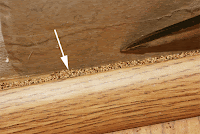 Drywood termites are not a common problem in many parts of Texas, except along the coastal bend areas from Port Arthur to the lower Gulf coast. Nevertheless, drywood termites can show up anywhere in the state. For this reason, PMPs should always be on the alert for signs of these insects.
Drywood termites are not a common problem in many parts of Texas, except along the coastal bend areas from Port Arthur to the lower Gulf coast. Nevertheless, drywood termites can show up anywhere in the state. For this reason, PMPs should always be on the alert for signs of these insects.Drywood termites belong to a different insect family (Kalotermitidae) than the more common subterranean termite (Rhinotermitidae). One of the differences in this family is that all colony workers are immatures, and there is no true worker caste. Another difference is these termite's ability to conserve water and live with no direct soil contact.
One of the best clues that drywood termites are present in a home is the presence of many tiny, six-sided fecal pellets that are ejected from the colony by the termites, or which spill from damaged wood that has been exposed by probing or carpentry activity. The pellets themselves are easier to spot than the ejection holes; but once found, ejection holes can be used as a portal to inject foam or liquid termiticides into infested wood.

Fecal pellets are often less than 1 mm long, and vary in color from light tan to reddish to black. Surprizingly, the color of the pellets seems unrelated to the color of the wood on which they feed. Look for pellets along molding in living areas, when conducting attic inspections, and around window areas. Wings are another sign of drywood termite activity. Look for termite wings in window areas or spider webs in the corners of attics or
 rooms.
rooms.Just because you've never seen drywood termites in your community before doesn't mean they aren't there. Away from the more temperate, humid areas of the state, where they swarm and spread naturally, most drywood termite infestations are imported by humans via furniture or construction lumber. Because these termites reproduce and feed more slowly than subterranean termites, it may take many years for the colony to mature and begin producing swarmers.
Drywood termites are a good example of a pest that may or may not be seen frequently in your area, but one that all pest management professionals should know something about. Keen eyes and an ability to spot things out of the ordinary are skills that will help separate you from your competition.
No comments:
Post a Comment